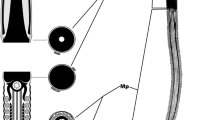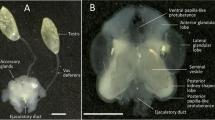Abstract
Sperm ultrastructure has been described for several species of Serpentes and other Squamata in which it has been considered a valuable character source for phylogenetic studies. However, some ultrastructural traits have been also reported as adaptations to increase motility and/or longevity under sperm competition and storage conditions. Bothrops alternatus and Bothrops diporus are medium sized, viviparous, highly venomous species, and their reproductive cycles include periods of female sperm storage between mating and fertilization. In this work we provide, for the first time, a detailed ultrastructural description of the spermatozoa of B. alternatus and B. diporus and discuss its possible relation to their reproductive features. Sperm was obtained from the vas deferens, and was processed to obtain transmission electron micrographs and fluorescence micrographs. Spermatozoa of these species show similar morphological traits, which are closely related to the general model described for the Serpentes. Furthermore, several synapomorphies for the squamates can be identified in these cells. Nevertheless, the observed midpiece elongation and absence of dense bodies could augment the energy producing capabilities of the spermatozoa, thus enhancing the competitive aptitude of the ejaculate.




Similar content being viewed by others

References
Al-Dokhi OA (2004) Electron microscopic study of sperm head differentiation in the Arabian horned viper Cerastes cerastes (Squamata, Reptilia). J Biol Sci 4:111–116
Aldridge RD (1975) Environmental control of spermatogenesis in the rattlesnake Crotalus viridis. Copeia 1975:493–496. doi:10.2307/1443648
Aldridge RD (1979) Seasonal spermatogenesis in sympatric Crotalus viridis and Arizona elegans in New Mexico. J Herpetol 13:187–192. doi:10.2307/1563927
Almeida MT (1999) História natural de Bothrops pubescens (Serpentes, Viperidae). Unpublished MS thesis, Universidade Estadual Paulista
Almeida-Santos SM, Salomão MG (2002) Reproduction in Neotropical pitvipers, with emphasis on species of the genus Bothrops. In: Schuett GW, Höggren M, Douglas ME, Greene HW (eds) Biology of the vipers. Eagle Mountain Publishing, Utah, pp 445–462
Anderson M, Dixson A (2002) Motility and the midpiece in primates. Nature 416:496. doi:10.1038/416496a
Campbell JA, Lamar WW (1989) The venomous reptiles of Latin America. Connell University Press, New York
Duvall D, Arnold S, Schuett G (1992) Pitviper mating systems: ecological potential, sexual selection and microevolution. In: Campbell J, Brodie E (eds) Biology of the pitvipers. Selva Press, Tyler, pp 169–184
Ferreira A, Dolder H (2003) Sperm ultrastructure and spermatogenesis in the lizard Tropidurus itambere. Biocell 27:353–362
Giojalas L, Rovasio R, Fabro G, Gakamsky A, Eisenbach M (2004) Timing of sperm capacitation appears to be programmed according to egg availability in the female genital tract. Fertil Steril 82:247–249. doi:10.1016/j.fertnstert.2003.11.046
Giraudo AR (2001) Serpientes de la Selva Paranaense y del Chaco Húmedo. Literatura of Latin America, Buenos Aires
Giraudo AR, Scrocchi GJ (2002) Argentinian snakes: an annotated checklist. Smithsonian Herpetological Information Service No. 132. Smithsonian Institution, Washington
Giugliano L, Teixeira R, Colli G, Báo S (2002) Ultrastructure of spermatozoa of the lizard, Ameiva ameiva, with considerations on polymorphism within the family Teiidae (Squamata). J Morphol 253:264–271. doi:10.1002/jmor.10002
Harding M, Aplin K, Mazur M (1995) Ultrastructure of Australian blindsnakes, Ramphotyphlops spp. (Typhlopidae, Squamata): first observations on the mature spermatozoon of Scolecophidian snakes. In: Jamieson BGM, Ausio J, Justine J (eds) Advances in spermatozoal phylogeny and taxonomy. Muséum National d’Histoire Naturelle, Paris, pp 385–396
Hartmann MT, Marques OAV, Almeida-Santos SM (2004) Reproductive biology of the southern Brazilian pitviper Bothrops neuwiedi pubescens (Serpentes, Viperidae). Amphib Reptil 27:77–85. doi:10.1163/156853804322992850
Jamieson BGM (1999) Spermatozoal phylogeny of the vertebrata. In: Glagnon C (ed) The male gamete: from basic science to clinical applications. Cache River Press, Vienna, pp 303–331
Jamieson BGM, Koehler L (1994) The ultrastructure of the spermatozoon of the northern water snake, Nerodia sipedon (Colubridae, Serpentes), with phylogenetic considerations. Can J Zool 72:1648–1652
Janeiro-Cinquini TRF, Leinz FF, Farias EC (1993) Ovarian cycle of the snake Bothrops jararaca. Mem Inst Butantan 55:33–36
Johnson D, Briskie J (1999) Sperm competition and sperm length in shorebirds. Condor 101:848–854. doi:10.2307/1370074
Lee MSY (2005) Squamate phylogeny, taxon sampling, and data congruence. Org Divers Evol 5:25–45. doi:10.1016/j.ode.2004.05.003
Lee MSY, Hugall A, Lawson R, Scanlon J (2007) Phylogeny of snakes (Serpentes): combining morphological and molecular data in likelihood, Bayesian and parsimony analyses. Syst Biodivers 5:371–389. doi:10.1017/S1477200007002290
Monteiro C, Montgomery CE, Spina F, Sawaya RJ, Martins M (2006) Feeding, reproduction and morphology of Bothrops mattogrossensis (Serpentes, Viperidae, Crotalinae) in the Brazilian Pantanal. J Herpetol 40:408–413. doi:10.1670/0022-1511(2006)40[408:FRAMOB]2.0.CO;2
Nogueira C, Sawaya RJ, Martins M (2003) Ecology of the pitviper, Bothrops moojeni, in the Brazilian Cerrado. J Herpetol 37:653–659. doi:10.1670/120-02A
Oliver S, Jamieson BGM, Scheltinga D (1996) The ultrastructure of spermatozoa of Squamata. II. Agamidae, Varanidae, Colubridae, Elapidae and Boidae (Reptilia). Herpetologica 52:216–241
Olsson M, Madsen T (1998) Sexual selection and sperm competition in reptiles. In: Birkhead T, Møller A (eds) Sperm competition and sexual selection. Academic Press, London, pp 503–578
Olsson M, Madsen T, Shine R (1997) Is sperm really so cheap? Costs of reproduction in male adders Vipera berus. Proc R Soc Lond 264B:455–459. doi:10.1098/rspb.1997.0065
Salomão MG, Almeida-Santos SM (2002) The reproductive cycle of male Neotropical rattlesnakes (Crotalus durissus terrificus). In: Schuett GW, Höggren M, Douglas ME, Greene HW (eds) Biology of the vipers. Eagle Mountain Publishing, Utah, pp 507–514
Schuett G (1992) Is long term sperm storage an important component of the reproductive biology of temperate pitvipers? In: Campbell J, Brodie E (eds) Biology of the Pitvipers. Selva Press, Tyler, pp 169–184
Shine R (2003) Reproductive strategies in snakes. Proc R Soc Lond 270B:995–1004. doi:10.1098/rspb.2002.2307
Silva VX (2004) The Bothrops neuwiedi complex. In: Campbell J, Lamar W (eds) The venomous reptiles of the Western Hemisphere. Comstock Publishing Associates-Cornell University Press, Ithaca, pp 410–422
Slowinski J, Lawson R (2002) Snake phylogeny: evidence from nuclear and mitochondrial genes. Mol Phylogenet Evol 24:194–202. doi:10.1016/S1055-7903(02)00239-7
Tavares-Bastos L, Teixeira R, Colli GR, Báo SN (2002) Polymorphism in the sperm ultrastructure among four species of lizards in the genus Tupinambis (Squamata: Teiidae). Acta Zool 83:297–306. doi:10.1046/j.1463-6395.2002.00119.x
Tavares-Bastos L, Colli GR, Bao SN (2008) The evolution of sperm ultrastructure among Boidae (Serpentes). Zoomorphology 127:189–202. doi:10.1007/s00435-008-0062-8
Teixeira RD, Colli GR, Báo SN (1999a) The ultrastructure of the spermatozoa of the lizard Micrablepharus maximiliani (Squamata, Gymnophtalmidae), with considerations on the use of sperm ultrastructure characters in phylogenetic reconstruction. Acta Zool 80:47–59. doi:10.1046/j.1463-6395.1999.20010.x
Teixeira RD, Vieira G, Colli GR, Báo SN (1999b) Ultrastructural study of spermatozoa of the neotropical lizards, Tropidurus semitaeniatus and Tropidurus torquatus (Squamata, Tropiduridae). Tissue Cell 31:308–317. doi:10.1054/tice.1999.0047
Teixeira RD, Scheltinga DM, Trauth SE, Colli GR, Báo SN (2002) A comparative ultrastructural study of the teiid lizards Cnemidophorus gularis gularis, Cnemidophorus ocellifer and Kentropyx altamazonica (Reptilia, Squamata, Teiidae). Tissue Cell 34:135–142. doi:10.1016/S0040-8166(02)00021-6
Tourmente M, Cardozo G, Bertona M, Guidobaldi A, Giojalas L, Chiaraviglio M (2006) The ultrastructure of the spermatozoa of Boa constrictor occidentalis, with considerations on its mating system and sperm competition theories. Acta Zool 87:25–32. doi:10.1111/j.1463-6395.2006.00217.x
Valdujo PH, Nogueira C, Martins M (2002) Ecology of Bothrops neuwiedi pauloensis (Serpentes: Viperidae: Crotalinae) in the Brazilian Cerrado. J Herpetol 36:169–176
Vidal N, Hedges B (2005) The phylogeny of squamate reptiles (lizards, snakes and amphisbaenians) inferred from nine nuclear protein-coding genes. C R Biol 328:100–1008
Vieira GHC, Colli GR, Báo SN (2004) The ultrastructure of the spermatozoon of the lizard Iguana iguana (Reptilia, Squamata, Iguanidae) and the variability of sperm morphology among iguanian lizards. J Anat 204:451–464. doi:10.1111/j.0021-8782.2004.00300.x
Acknowledgments
We are grateful to Dr. Gerardo Leynaud of the Centro de Zoología Aplicada (Universidad Nacional de Córdoba) for providing the specimens; to Dr. Cristina Maldonado for her assistance with electron microscopy and micrographic techniques. This study was funded by the Consejo Nacional de Investigaciones Científicas y Tecnológicas (CONICET), and by the Secretaría de Ciencia y Técnica (SeCyT) of the Universidad Nacional de Córdoba, Argentina. Biol. Maximiliano Tourmente is a fellow of the Consejo Nacional de Investigaciones Científicas y Tecnológicas (CONICET) and a student of the Doctorado en Ciencias Biológicas of the Nacional University of Córdoba. Dr. Laura Giojalas is a member of the Research Career of the Consejo Nacional de Investigaciones Científicas y Tecnológicas (CONICET).
Author information
Authors and Affiliations
Corresponding author
Rights and permissions
About this article
Cite this article
Tourmente, M., Giojalas, L. & Chiaraviglio, M. Sperm ultrastructure of Bothrops alternatus and Bothrops diporus (Viperidae, Serpentes), and its possible relation to the reproductive features of the species. Zoomorphology 127, 241–248 (2008). https://doi.org/10.1007/s00435-008-0067-3
Received:
Revised:
Accepted:
Published:
Issue Date:
DOI: https://doi.org/10.1007/s00435-008-0067-3



